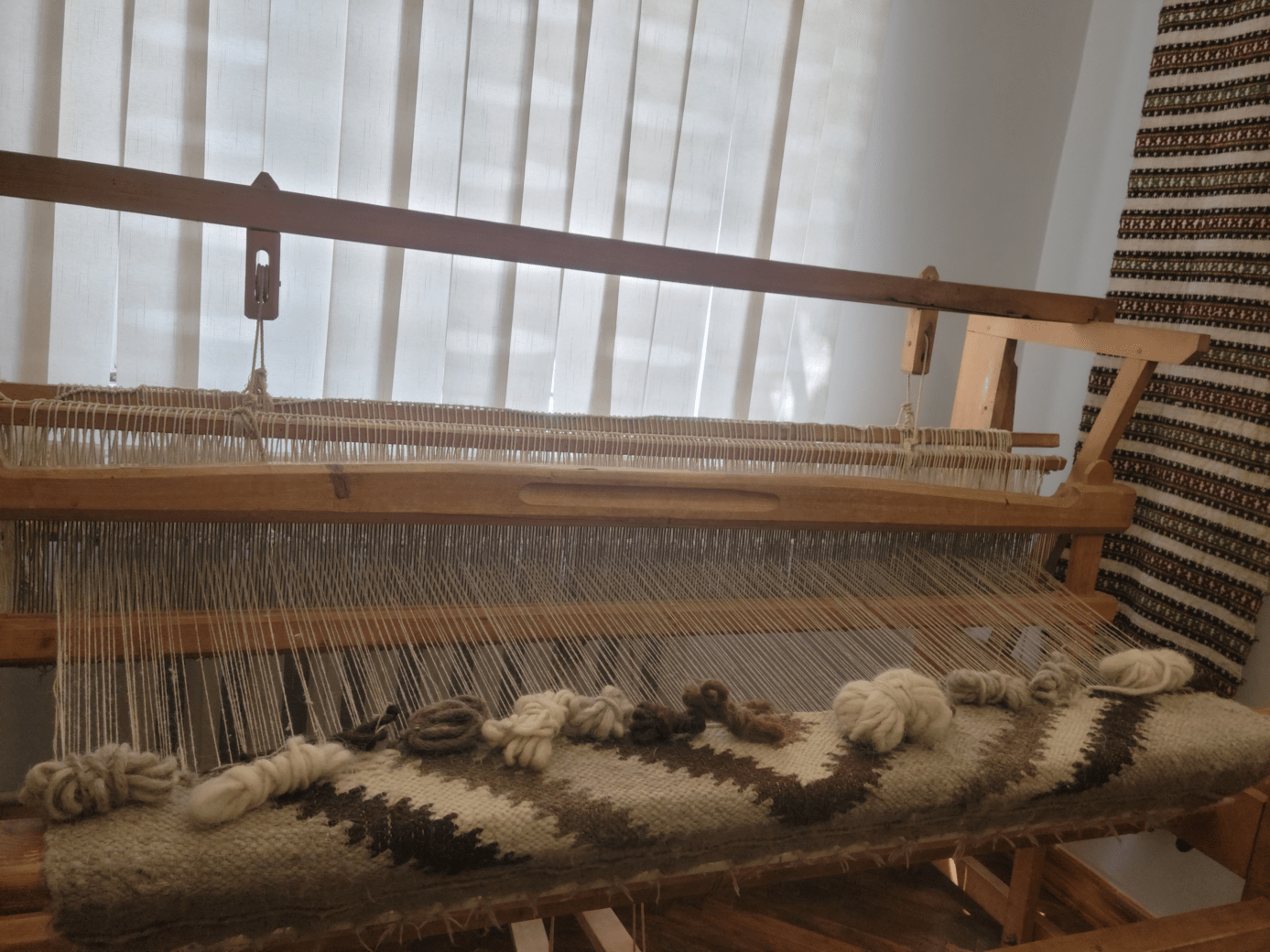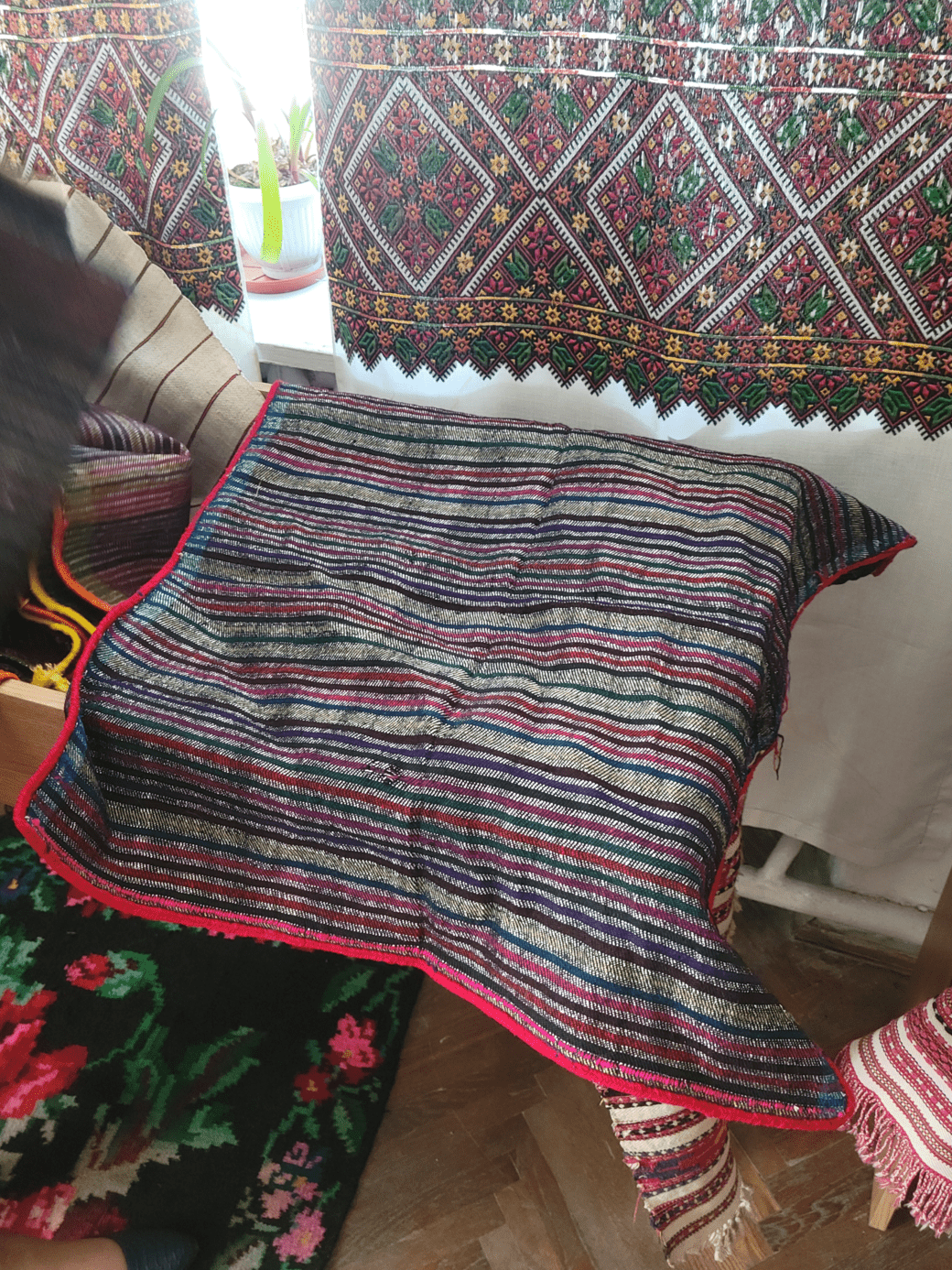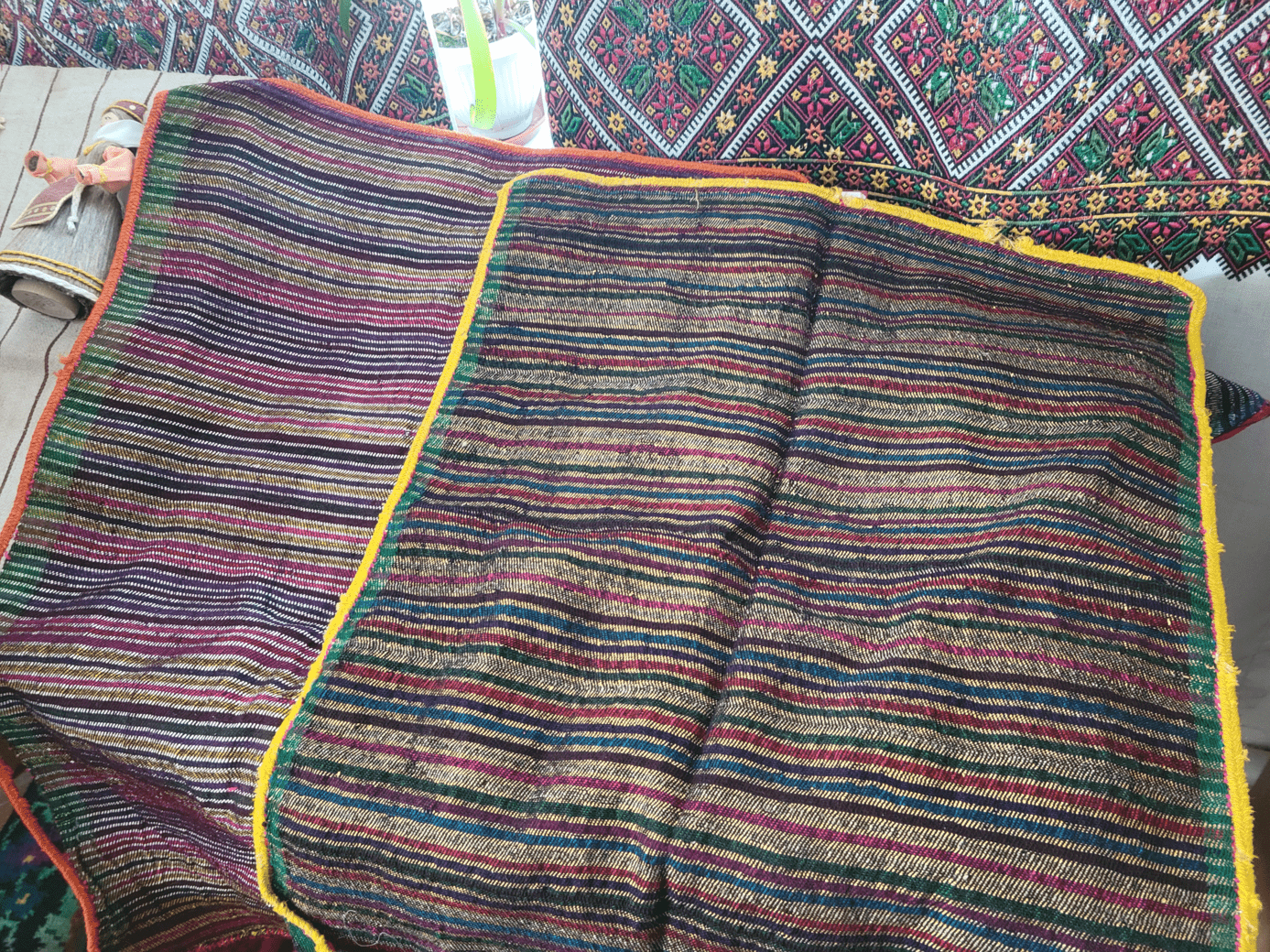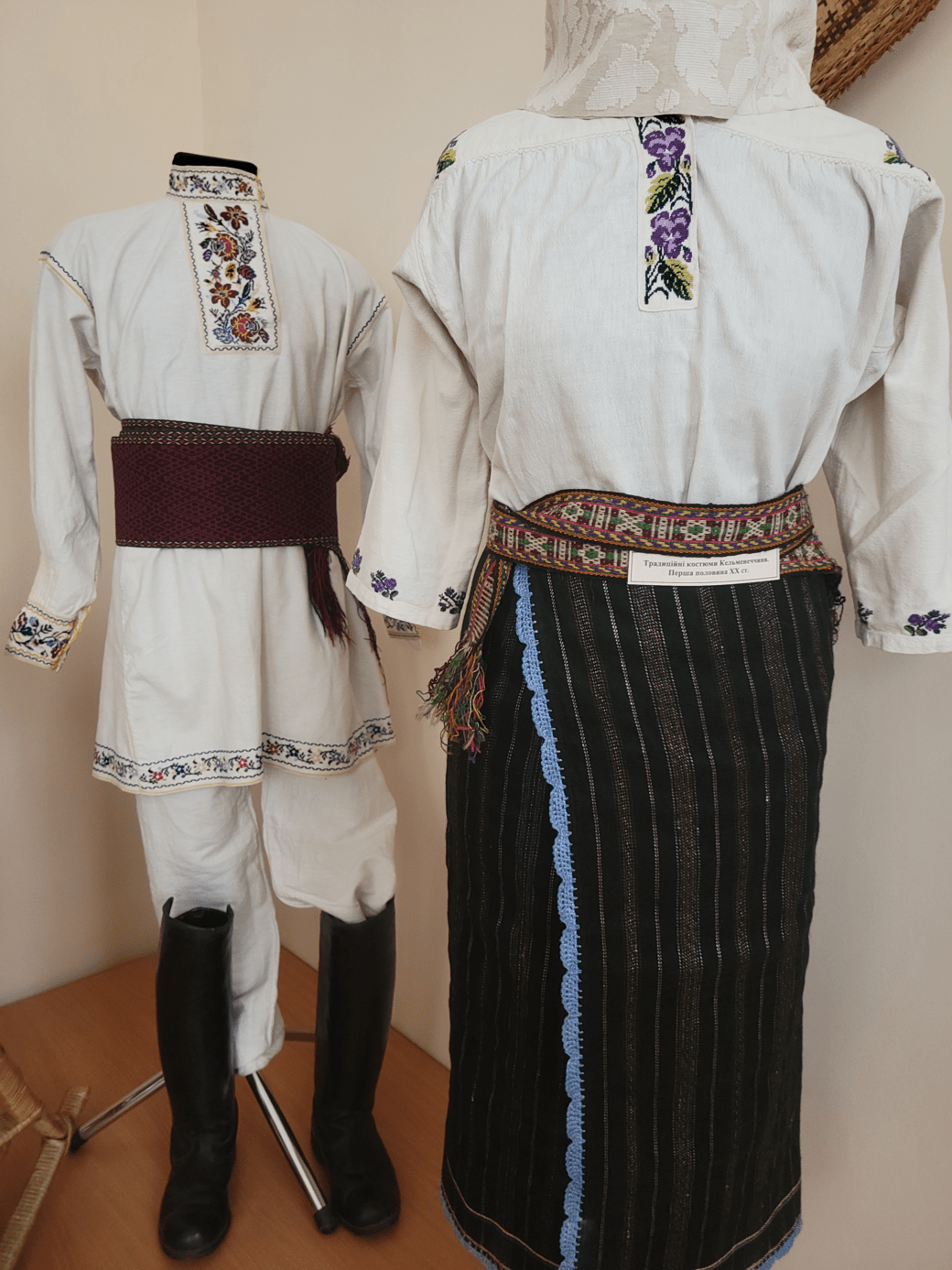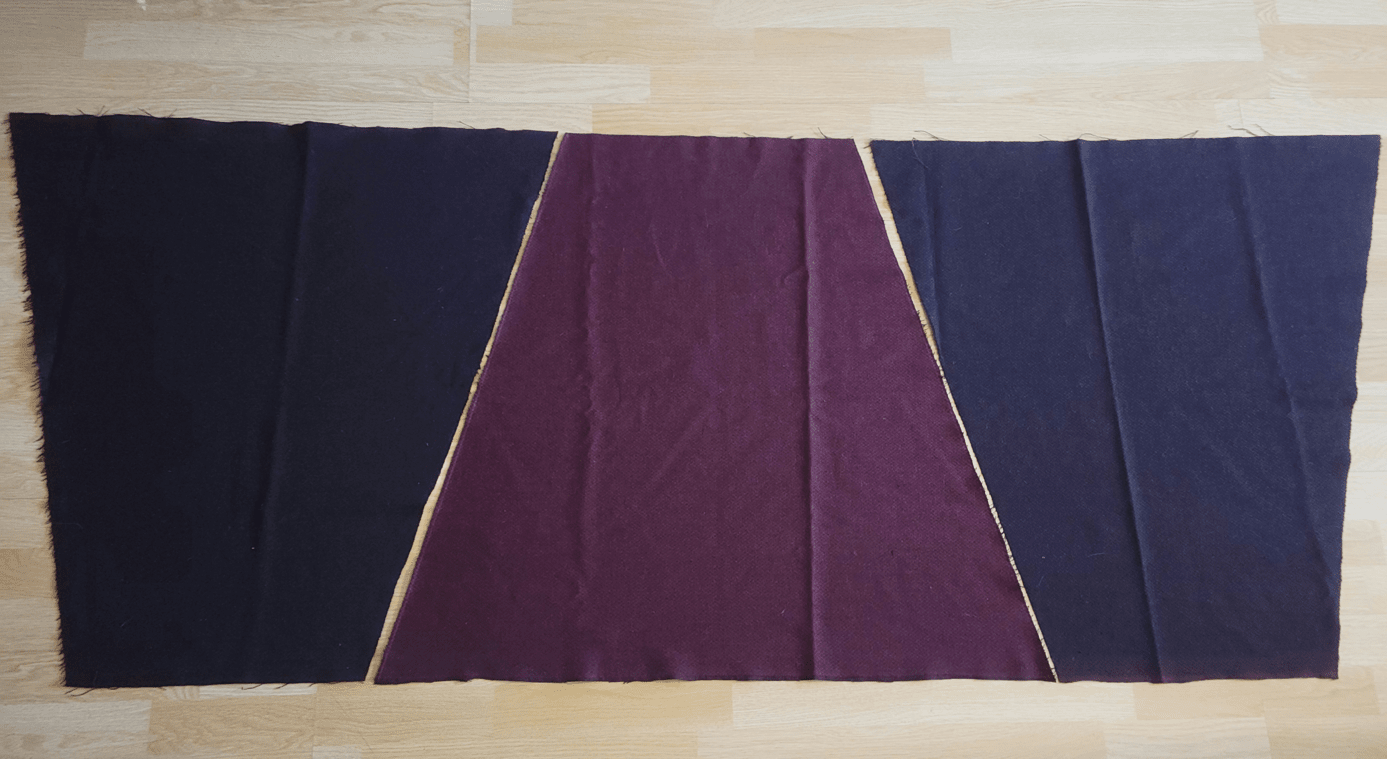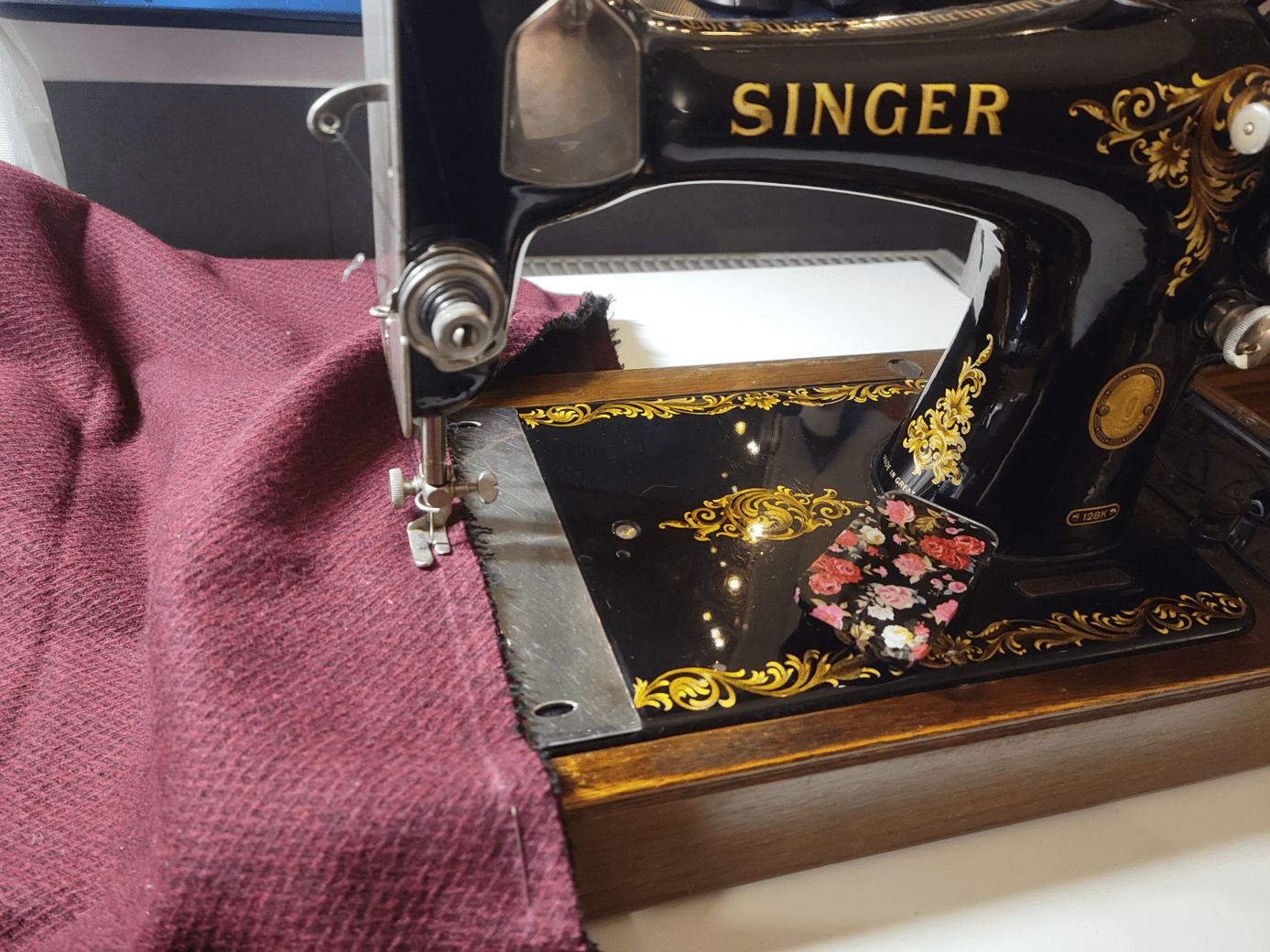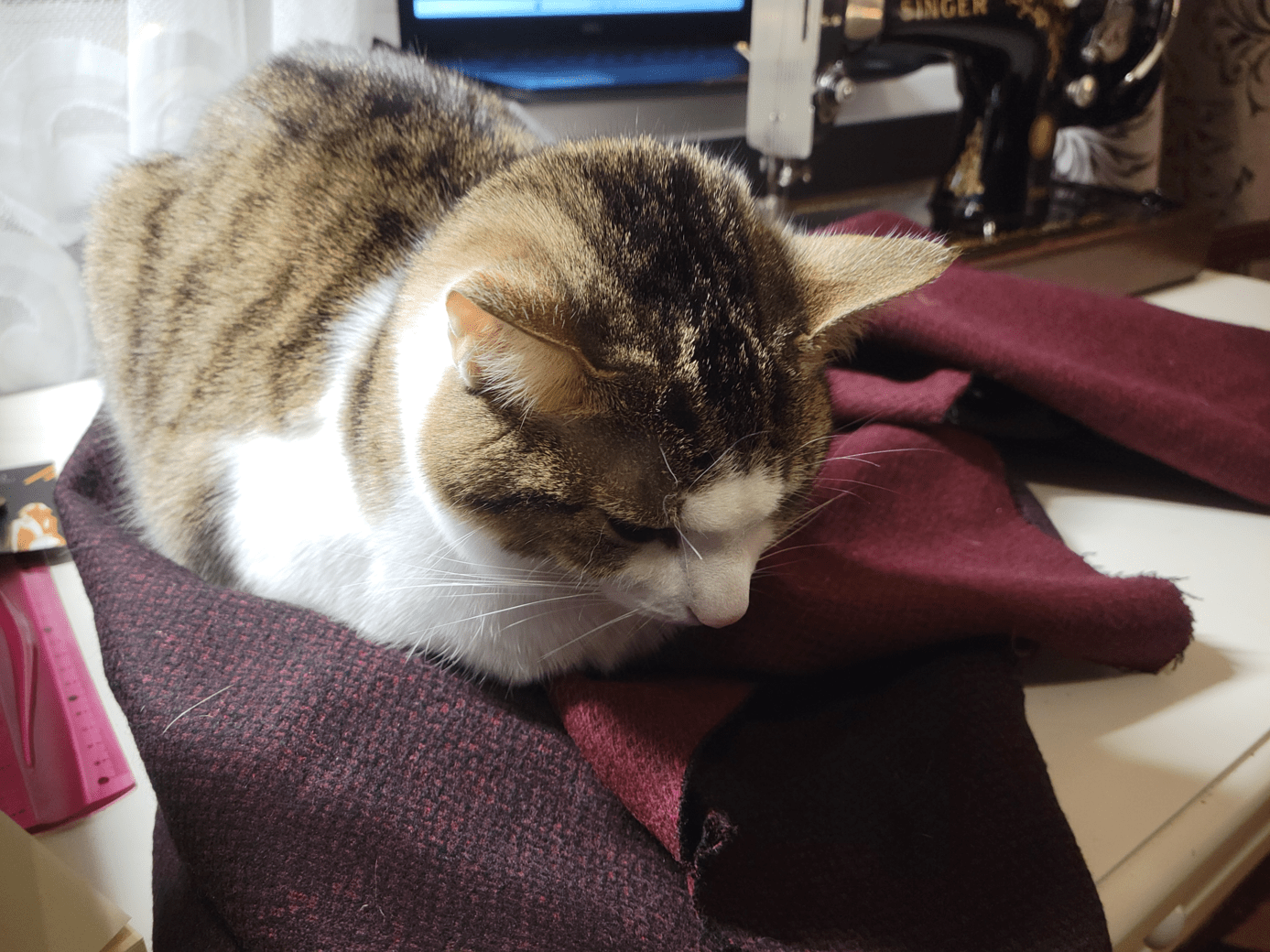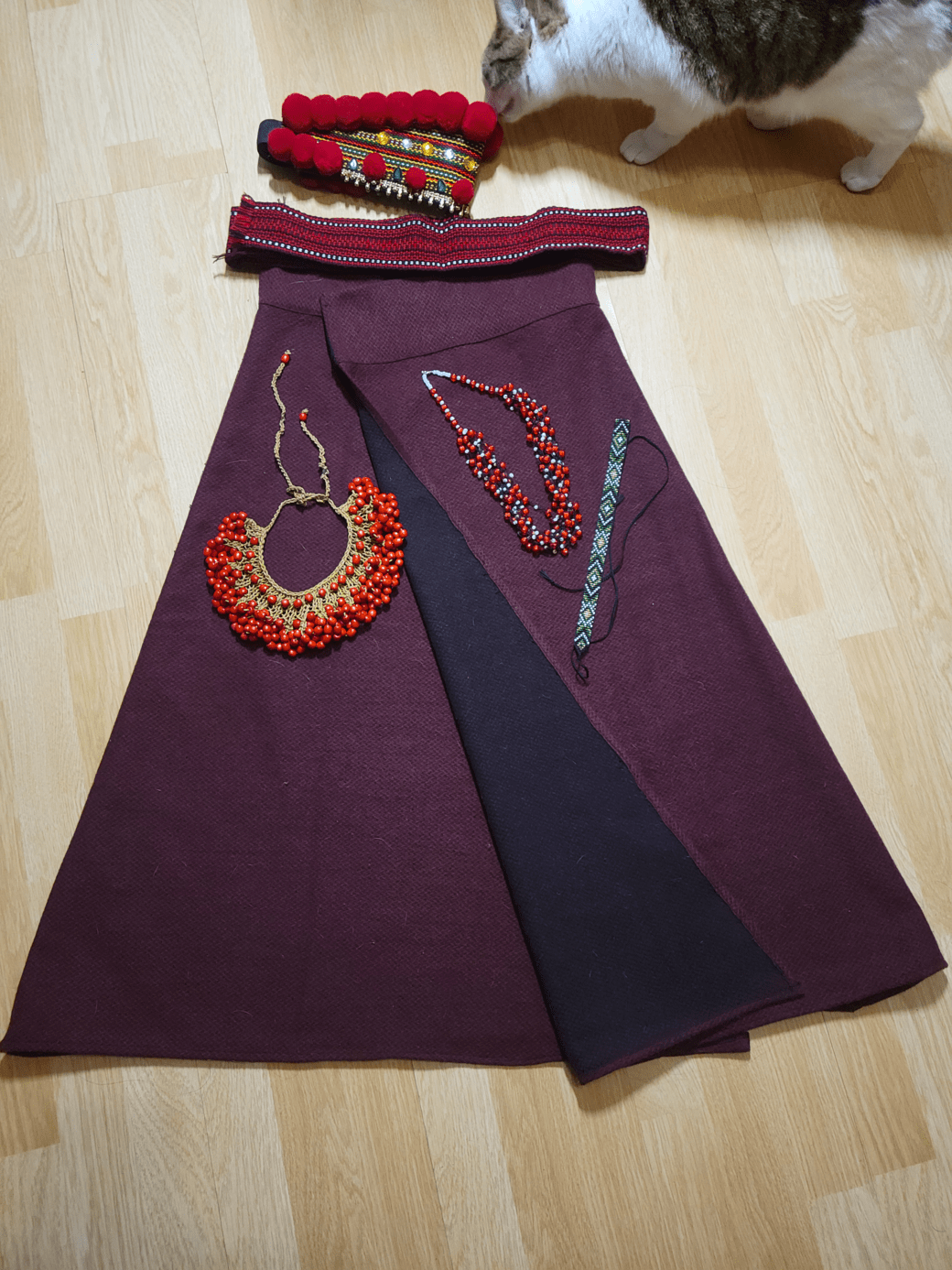Opynka
The opynka has been, by far, the easiest part of my dress to technically craft. However, tracing its history and construction has been an ongoing challenge. So, this page will inevitably deal with topics like generalizations when discussing folk dress.
The opynka (also called obhortka, horbotka, plakhta, etc.) is simple: it is a wide rectangle of handwoven, woolen fabric that is wrapped around the waist, then fastened with a woolen belt. It is used in folk dresses in parts of southwestern Ukraine (Pokuttia, Bukovyna, Podillia) and nearby regions, like Bessarabia.
Here, it is relevant to provide a brief explanation of the dress itself. The folk dress of Sniatyn consists of two main parts: the sorochka and the opynka. The sorochka is a linen smock that is ankle-length and embroidered around the upper sleeves, cuffs, collar, and occasionally the hem. The opynka is then wrapped over the sorochka at the waist. The opynka is fairly long, but not long enough to hide the sorochka entirely, so that the bottom hem of the sorochka may be seen. It should also be noted that a sheepskin vest, the keptar, is often worn in the Sniatyn region, though I have not included it in my project. Here is a great video demonstrating all of the different parts of the Sniatyn folk dress together.
Anyone familiar with historical fashion will likely know the importance of the silhouette when distinguishing different periods of fashion – as Karolina Żebrowska demonstrates in this cute video on 19th-century Western dresses. To some extent, this also applies to folk dresses when it comes to region, albeit in a broader sense. For Sniatyn, we know that the dress, formed from the sorochka and opynka, is long and rather straight. Such a silhouette may easily be contrasted with regions like Polissia, where pleated skirts add more form and volume to the lower half of the dress. As such, the addition of an opynka completes the silhouette of a Sniatyn folk dress. It was an easy decision to include the opynka in my own dress, though research and design for it took a bit more work.
A Brief History
Considering the readily available information about Sniatyn embroidery, it may be a bit surprising to find that information about the local opynka is rather difficult to find. That can be explained fairly well by the history of weaving them in the region.
As with many other cultures, Ukrainians have been handweaving fabric for many centuries now. Up until industrialization around the 19th century, handweaving was the only way to get cloth for clothing/etc. A given village generally had very few weavers, as the looms and skills needed were complex and resource-consuming. Families would spin their own thread, then pass it onto a weaver for it to be woven into fabric. There are quite a few surviving historical looms from around Ukraine, which can be viewed here. I have been fortunate enough to have viewed the last 2 types of looms (one from an unnamed folk festival and the other in Kolomyia) for myself. The first of these two was in use around the Kolomyia region for the purpose of making belts. As for the second, I was able to see that exact loom in Kolomyia as well as several others of the type in Kosiv, which are indeed used for very thick textiles.
According to Ukrainian ethnographer Nikolayeva (p. 24), the opynka has a long history in peasant dress, having already been common in Kyivan Rus (9th – 13th c.). They have some shared features with skirts in Romania, Moldova, and Bulgaria, indicating their ancient roots. Weaving of the opynka continued uninterruptedly up to the 20th century, when handweaving was replaced by industrialization. Throughout this time, Ukrainian women around the Sniatyn region would have owned at least one opynka.
While handweaving in general is still practiced around Kosiv and other nearby regions (particularly Bukovyna), it has been dormant in the Sniatyn region for some time now. The official story of the Sniatyn opynka more-or-less ended by the mid-20th century. Due to industrialization and modernization around the turn of the century, weavers certainly would’ve struggled to maintain their careers. And considering the sudden wane of the opynka in Sniatyn after the start of the 20th century, it’s likely that the region has not seen a professional weaver since the pre-WW2 era. If there had been attempts to maintain professional weaving, it may well have been prevented in the post-war era, as Western Ukraine was annexed into the USSR and brought under Soviet policies hostile towards cottage industries. Barring someone weaving their own fabric or hiring a weaver (which can, of course, be quite costly), obtaining reconstructed fabric for the Sniatyn opynka is rather difficult today.
Nowadays, without access to weavers, those wearing the Sniatyn folk dress often find alternatives that are aesthetically close to the original. There is some opportunity to buy older skirts from collectors, but this isn’t always the best option for wearing, as a majority of them have already been damaged with time. As mentioned, hiring a weaver to make the fabric may also be an option, but it would be costly and require searching for a weaver outside of the Sniatyn region. It has become increasingly common for women looking to assemble their own Sniatyn folk dress to adapt to new solutions; I will discuss two examples of these adaptations for the red and black opynka below. So, while the actual Sniatyn opynka is slowly dying out, it is still adapted and imitated in the various ways available today.
Describing the Opynka
Referring to Nikolayeva again, at its very base, the opynka is a wrap skirt that consists of either one unsewn piece of fabric or three panels of fabric stitched together. The cut of the skirt was chosen by the weaver depending on the development of folk artistic weaving, with a preference toward one piece of fabric when adding complex ornamentation. The opynka is either black or red (p. 134).
I shall note briefly here that the opynka is worn about the waist and historically held into place with a woolen belt. As mentioned above, the opynka itself is little more than a rectangle of heavy, woolen fabric. This means that it can be rather restricting, which is why they have often been worn with one corner (or both corners) pulled up and tucked into the woolen belt.
There is some generalization that the Pokuttia region wears red (and therefore, Sniatyn wears red), whereas other regions wear black. Though this could well be the case for the Kolomyia and Horodenka regions, this is not the case for Sniatyn. Herein lies the problem of generalizations and trying to apply strict rules to folk dress, perhaps especially in the case of Sniatyn, which is at the border of and is influenced by 3 different folk regions (Pokuttia, Bukovyna, and Hutsul). But we’ll get into my exact frustrations with these generalizations and rules further below.
Although it may be tedious to note down by ethnographers and collectors, variation in folk dress often existed/exists and was even encouraged. In Sniatyn, we have 2 colors for the opynka: red and black. When one has the patience to search through private collections and online listings from Sniatyn with the different dialectal names for the opynka, both red and black skirts are pulled up consistently. I have found that the red opynka is favored by more professional private collectors (perhaps in the pursuit of finding the “authentic” Sniatyn opynka from the above generalization), whereas the black opynka tends to be more common in online listings. It’s also worth noting here that the ethnographic exhibit in the museum in Sniatyn holds black skirts; if only red was worn, it likely would’ve been represented instead. In any case, it would appear that both red and black were possible choices in historic dress. It’s a shame that the black opynka skirts in Sniatyn are rarely acknowledged (especially in English); it erases the wonderful variations and creativity in our historic dress.
In terms of which color opynka should be worn, there was no actual rule or meaning. It wasn’t tied to identity, marital status, etc. in any tangible way. From Ukrainian ethnologist Kateryna Mateyko’s ethnographic dictionary (p. 59): “Колорит обгорток завжди узгоджений із колоритом пояса та вишивки на сорочках.” (The color of the obhortka [another name for the opynka] is always coordinated with the color of the belt and the embroidery on the shirt.)
Okay, so we know that it rather depends on the embroidery. I’ll discuss the embroidery more in depth elsewhere, so I’ll stay focused here. Let’s put this into the perspective of my dress. For the Sniatyn region, since I am embroidering my dress by myself, I have free reign to choose from both black and red as well as some newer colors, such as whitework and more colorful floral patterns. “Coordination” is a vague term, but based on various archival and modern uses, my assumption here is as follows: predominantly red embroidery is matched with a red opynka; predominantly black embroidery is matched with a black opynka; and either color is perfectly acceptable and up to the wearer’s discretion for embroidery that is both red and black / whitework / colorful floral. Now, red + black is a fairly common option for Sniatyn embroidery, and one that I have chosen myself.
So, to put it simply, based on my embroidery, the color of my opynka is simply a matter of personal taste and preference.
Now that we understand the basic construct of the opynka and how it’s chosen, we can delve into the specifics and actual examples of both types.
The Red Opynka
Since the red opynka is more commonly discussed for Sniatyn, we’ll start there. In terms of construction, the red opynka consists of three rectangular panels (the pieces of fabric made to construct the skirt). As shown here, the typical red opynka consists of a plain black back panel plus two front striped, red panels. I would assume that this black panel may have been used to reduce the cost of the skirt, as the decorative red fabric is more complex and has more colors. While this black panel is sometimes presented as a rule in the Sniatyn opynka, it isn’t clear whether this is always the case considering the given photos and illustrations. I have found examples of the opynka without the black panel, such as this one from neighboring Kolomyia. In other words, if cost or time is not an obstacle for someone, then this black panel may indeed be optional. The red fabric is decorated with either gold or multicolored stripes (like this one); these stripes are vertical when worn.
As for the progression of the fabric pattern used for the opynka in the Sniatyn region, I have referenced those in Bukovyna. Traditionally, the fabric consisted of narrow stripes that were spaced widely apart. In the 20th century, these stripes became wider. It seems that Sniatyn may have followed this progression; many of the overskirts from Sniatyn that have been documented consist of wide stripes. In some cases, the hem is decorated with lighter colors. The overskirts in Bukovyna later replaced these plain stripes for geometric and floral designs, but I have not found much to suggest that Sniatyn followed this trend for the red opynka (or that Sniatyn continued weaving in general).
Modifications to the neighboring Bukovyna opynka were introduced in the 20th century. Noticeably, the newer ones switched from calf-length to knee-length as modern fashion turned to shorter skirts. Considering that other regions also shortened their skirts as time went on, I would assume that the Sniatyn opynka may have seen the same change.
Pleated, Floral Alternative
A more contemporary alternative to the red opynka is a pleated, red skirt with printed floral patterns. This style seems to be more common in the eastern Sniatyn region, such as in Zavallia, which is closer to Bukovyna and, thereby, the Bukovynian floral skirts. These skirts are made from industrially printed cotton fabric. Here is an archival photograph from Zavallia of several women wearing a pleated (assumably red) floral skirt. A newer version of this alternative style may be seen here. And here is another newer example. So, for women looking for a more accessible adaptation of the older opynka, this is a readily available and modern option.
The Black Opynka
Unlike the red opynka, the black opynka is a bit difficult to pin down in certain terms. This is because 3 different foundational styles may be found across the Sniatyn region. Please note that variations of these skirts may also be found in neighboring Bukovyna. We will end this section with the modern alternative to the black opynka.
Black + Even Stripes
Perhaps the most common black opynka that may be found in the region is a black version of the red opynka discussed above. These ones are woven in one panel but are missing stripes in the middle of the fabric, signaling the back of the skirt. This opynka has either gold or multicolored vertical stripes. Most of the surviving skirts today have narrow stripes with wide spaces between them. Many of them feature wide, horizontal red stripes, bordered by thin gold / green / blue stripes, along the length of the fabric, though some do not. Several examples survive today:
-
Here is an archival photo of a woman in 1920 wearing a black opynka.
-
Here is an example of one with gold stripes and the red border; and here is another example.
-
Perhaps my favorite, here is an example of one with multicolored stripes, no red border, but thin gold and blue stripes running along the length of the fabric.
-
A last interesting example here is a woman wearing a black opynka with a red border, but turned so that the stripes run horizontally instead of vertically. While it is difficult to be certain from the photo, I suspect that she has wrapped the width of the fabric around her waist, so that the excess length must then be folded up into a second layer. The result is a shorter opynka, which would have allowed for more movement when working. Note that she is wearing a colorful, floral vyshyvanka with this black opynka.
Grey + Varied Stripes
This second type is represented in the M. Cheremshyna Literary Museum in Sniatyn. They are actually pretty reminiscent of the Hutsul skirt, though Hutsul skirts typically have horizontal stripes, whereas Sniatyn has vertical stripes. This opynka is also woven in one panel, but it is covered entirely with stripes, including on the back of the skirt. It has a mid-to-dark grey base with multicolored vertical stripes. These stripes vary in width, with some being quite narrow and others being noticeably wider. They are unevenly spaced as well; the stripes are either randomly interspersed at intervals across the fabric or are spaced in groups. The stripe colors also change from opynka to opynka. The most common colors are varying shades of black, red, green, blue, purple, and pink. Some skirts use all of these colors, while others only use certain matching sets, such as blue, pink, and purple.
While these skirts do not have a red border like the first type, they do have a very interesting addition: an added border around the entire piece of fabric. This would have likely been done to add extra protection against fraying of the fabric as well as to further decorate the skirts. The borders were historically made by braiding thick strands of yarn, then sewing these braids onto the edges of the fabric. The colors used for these borders are always bright, with orange, red, and yellow being represented in the Sniatyn museum. In newer skirts from Bukovyna, crochet is used to create these borders instead; one Bukovynian skirt at the museum in Chernivtsi, for example, has a crocheted border. So, crochet may have been used in Sniatyn too, if the weaving tradition had survived.
Borrowing from Bukovyna
Since the weaving tradition in Sniatyn has waned, some women have turned to neighboring Bukovyna to acquire their skirts. This influence certainly makes sense for the eastern part of the Sniatyn region, which closely neighbors Bukovyna. Here is an example of a woman from Zavallia (southeastern Sniatyn village) wearing a Bukovyna skirt. This opynka, like many other newer Bukovynian skirts, is black with wide vertical stripes of subdued floral patterns. So, for some women, acquiring a handwoven opynka from Bukovyna instead is an acceptable practice.
Plain Black Alternative
When the historical black opynka cannot be acquired, the common alternative is to instead wear a plain black skirt. This replacement has been around for quite some time, as evidenced by archival photographs like this one and this one. This alternative is found in multiple villages across the Sniatyn region. These replacement skirts are usually long, around calf-length. There is no set fabric type needed for these plain black alternatives. Modern styles, such as pencil skirts, are commonly used to replace the opynka today. In this way, the historical style of the traditional folk dress is made more accessible.
My Original Design & Problems
My most basic goal when making the opynka was that I wanted to be able to wear it in everyday life. As a student and worker, it is rather important to me that what I make can be useful in a variety of contexts, instead of just sitting around for most of the year. That is, it should be functional outside of this project. Just as my vyshyvanka can be paired with jeans and worn in everyday life, I wanted my opynka to also double as a normal skirt. This gave me a good sense of how I would design and make mine, which will be explained in detail further below.
But this initial decision wasn’t the problem. It was the color of the opynka that caused trouble throughout this part of my project.
When I began designing my opynka, my references (both in English and Ukrainian) referred relentlessly to the Sniatyn opynka as being red. Readily accessible photos always push the red opynka at the forefront, and private collectors (like digital archives) exclusively assign Sniatyn the red opynka. I took the generalization as fact, and I made my opynka red, even though something about that felt a bit off.
It felt off for a couple of reasons. First, I already knew from the diversity of embroidery patterns and necklaces that Sniatyn was not fond of just having one design. The Sniatyn folk dress is actually incredibly diverse and varied at every stage. And if embroidery is enthusiastically switched between red and black, why was the opynka so restricted in comparison? Second, Western Ukraine loves black, and most opynka skirts are actually black, so it felt a little odd that Sniatyn, which readily accepts black everywhere else in its design, would outright reject a black opynka. And third, Sniatyn closely neighbors the Bukovynian region, which has an abundance of black opynka skirts. Is it really difficult to imagine that some Sniatyn women of the past would see the black opynka and obtain them for themselves? Sniatyn folk dress has been the recipient of intercultural trade before, so ignoring the black opynka skirts that were just a stone’s throw away seemed a little unrealistic, all considered. Despite what my sources were saying, the generalization of Sniatyn wearing exclusively red didn’t sit well with everything else I knew about Sniatyn craft.
But when source after source insists on this generalization that Sniatyn wears red, it makes it difficult to find and recognize examples where that is disproven. Over time, I started to find traces of the black opynka, but my true breakthrough came when I was looking through my photos from the Sniatyn museum for the nth time for one of my other pages. While I was flipping through the photos, I landed on one of my photos of the black opynka skirts and froze. How many times had I looked at those photos without true recognition? I had previously become so accustomed to thinking of our opynka as being red that I had simply… not recognized my own photos of the black ones for several months. But these are undeniably opynka skirts, and the memory of the tour guide introducing them to me as wrap skirts surfaced along with recognition of the photos.
No joke, I cried when the connection was finally made in my mind. It was the last piece I needed to prove that the black opynka really existed in Sniatyn. All my suspicions were confirmed, and I felt so relieved and vindicated. After figuring this out and learning how to recognize the black opynka, I was able to gather so much more evidence of their existence. The generalization had been disproven.
While it was a relief, this also reveals so much frustration that I have with generalizations and rules when speaking about folk art, like the dress. When we speak in these definitive terms, we are at risk of looking only for those terms and not recognizing any deviations. If you’re constantly looking for red (like private collectors), you might just miss all the black skirts that coexisted at the same time. And once those go unrecognized, we’re missing out on all the diversity and unique character of these older traditions. If I had not looked at other parts of the Sniatyn dress and realized that our folk dress has so much innate variation, I may not have gone looking for the black opynka and simply accepted the generalization as divine truth. To do that would have been to severely misunderstand historical Sniatyn textiles and their craftswomen. I truly believe that we can only understand these traditions by also accepting the variations, deviations, and rarity of concrete rules.
But in the meantime, I have a red opynka. And it’s fine, but I (the crafter here) believe a black opynka would have looked nice with my black-red embroidery. Instead of acting on my own instinct, I listened to a false rule, and I will have to address that in the future now, as I will explain at the end of this page.
The Crafting Process
Starting from the top, I already had the fabric for my opynka in my possession. The fabric was given to me by a friend, another craftswoman. It was originally purchased here in Estonia. There was just enough of it left to make my skirt, which was fortunate. The fabric itself is wool (or a wool-blend at the least; I have not tested a sample), but luckily lightweight, so it’s not very thick or stiff. One side is a dark red, just a little bit darker than the typical red opynka, while the other side is black. There is a faint diamond pattern to the fabric (especially seen on the black side), but it’s overall quite plain. Since I would be wearing an underskirt or at least leggings underneath, I didn’t bother lining it on the inside. So, all I needed to add was black thread and Bonnie (my hand-crank sewing machine; see the Tools & Materials page for further info).
Next, I had to decide on the exact construction of the skirt. Admittedly, I wasn’t thrilled at the idea of just a rectangle held in place by only a belt (which, at the time of crafting, was in reference to the cheap belt I obtained in Ivano-Frankivsk; more information is on my Accessories page), especially considering the fabric does still have some weight to it. I settled on making a modified wrap skirt early on. The difference here is that I cut the fabric so that it is narrower at the waist than at the hem. I figured that a wrap skirt would at least make it easier for me to fasten the overskirt in place on my own, as there would be less fabric to manage. It has also helped achieve the silhouette of the historical opynka with this lighter-weight fabric. Like the traditional opynka, my skirt also has 3 panels: a back panel and two side panels.
For anyone interested in making their own, a good tutorial on how to make a simple wrap skirt can be found here.
Now for piecing it together. Following the precedent from Kolomyia linked above, I decided to keep all 3 panels red instead of having a black panel. This was just out of personal preference – I tend to like consistency with skirts. I sewed the panels together using a French seam (tutorial here). Again, this was just a personal preference; I find the French seam to be quick and easy, especially for thicker fabrics that bulk up quickly. I’m afraid that some of the seams on my opynka are not very straight, as achieving a straight seam can be a bit difficult on Bonnie since I only have one hand to guide the fabric. Regardless, the skirt is at least serviceable, and the black thread is not very noticeable, so I can put off fixing the wobblier seams for the future.
Hemming the skirt and attaching the waistband were my last steps. At the moment, my opynka is a bit longer than it perhaps should be (the eternal consequence of being short, really), though I may make changes to it in the future, so I’ve decided not to worry about it for now. I also consciously made the waistband a bit longer than the actual waist of the skirt; I like this a bit better personally, and it left room for last-minute adjustments.
Okay, well, the hem and waistband ended up not being my final steps. One thing I added to my opynka was a button. I hesitated a bit because the opynka traditionally does not have buttons or anything, just the belt. But again, I’m trying to be practical with this skirt, so I added a button to mine. Part of this was out of realism; my first Ukrainian belt for the overskirt is thin and remarkably flimsy; I never trusted it to hold the fabric up. So, I have 0 regrets about the button.
And, with that, I had an overskirt that looked quite similar to the Sniatyn opynka, but that also fit my own preferences and resources.
I found the actual crafting to be fairly easy to get through. I have been sewing all my life; my parents taught me when I was around 4 years old. I’ve made a couple of skirts before that were more complex than this one and involved actual math (a weak point for me). And I’ve sewn quite a few things with Bonnie over the past couple of years, including the aforementioned skirts. The wool fabric was easy to work with; Bonnie handled it well enough. There are imperfections in my sewing, sure, but I wasn’t stressed or nervous putting it together. In comparison to the research, actually making my own opynka was the most enjoyable part of this process, and I really wouldn’t mind making more opynka-based skirts in the future. The simplicity yet elegance of the opynka is so effortless and satisfying to craft.
Reflection & Future Plans
As I have said multiple times now, researching the opynka was much messier than actually making my own version.
The process of researching for the skirt was slow. The information was sporadic. Very little of what I did find discussed the actual Sniatyn opynka. I was left with a few photos and some vague rules about what the skirt needed. Some of it I was willing to discard immediately to make the skirt more practical, such as adding a button. But the color…
If I have one personal regret, it’s not having realized that the generalization was wrong earlier on. It genuinely might have changed how I made the skirt. I might’ve actually flipped the fabric so that the black side was showing instead of the red. When I realized that the generalization was wrong, I had the urge to rip apart my long-completed skirt and make it the color that I prefer, especially for the matching vyshyvanka.
And I might still flip it! Or, even better, try to find suitable black fabric for a new version of my opynka. Maybe someday I’ll even try to weave one for myself. I love the black opynka with the red hem band; it’s such a pleasing design to pair with my embroidery, and I really want to have my own someday. I will certainly have to revisit this and make the opynka as fitting as I can. It’s an item of clothing that I really do want to cherish, even if the closest I can get is through imitation. The more I have learned about the black opynka options, the more ways I have discovered to accentuate my embroidery in the future.
This project isn’t supposed to only encourage my integration into Ukrainian culture – it’s also about my contributing my own diverse style in return. Part of that process is learning more about regional Sniatyn heritage specifically, so that I can help maintain this one smaller facet of Ukrainian culture. But the contribution on the individual level of the crafter cannot be forgotten here. Like many other crafters, I am motivated a lot by getting to innovate older garments to my designs and preferences. A motivation to create is undoubtedly what keeps so much of Ukrainian folk heritage alive today. And that’s perfect! By innovating, contemporary Ukrainian crafters keep the older culture alive and relevant in today’s world. We do not leave these items in the past once a critical element is lost, but instead bring their memory into the modern day as best we can. I have made some changes to the historical opynka and want to experiment further in the future because I (the crafter) genuinely want the best for the survival of the opynka.
Personal reflections aside, researching the story of the opynka really illuminated this lost part of Sniatyn heritage. Yes, the original opynka is no longer being produced, and that sucks for trying to make a historically based folk dress, but that’s just the symptom of a greater loss. When I visited Sniatyn, there was no question that weaving had died out there, nor did there appear to be great interest in its revival. In a practical sense, it’s understandable; weaving fabric for the opynka requires proper equipment and resources to weave. It requires space, skills, and time to weave. With the tradition already being severed for roughly a century, quite a bit of effort would be needed to begin weaving the Sniatyn opynka again, let alone to continue developing it, like in Bukovyna. It’s increasingly unlikely that this heritage will be revived in Sniatyn.
I mourn for this long-lost heritage that I never got to see for myself. And in consequence, those of us trying to design our own Sniatyn dresses are left to imitate a craft that has been lost for a century in an attempt to recapture the aesthetic and silhouette.
But here is my solace: the memory of the original fabric is not lost. In photo after photo, I saw how different Sniatyn women grappled with the absent fabric and adapted their own versions. I saw dark red skirts that follow the aesthetic and drape of the original fabric but with new adaptations, such as the use of floral patterns and pleated fabric. The historical opynka lives on in these memories and new, creative adaptations of its original form. Even after its untimely death, the old weaving tradition and historical opynka are still remembered and loved.
